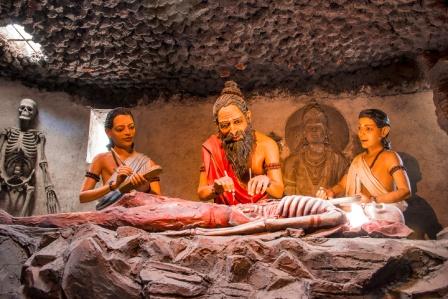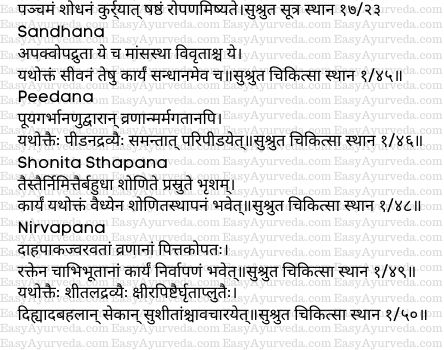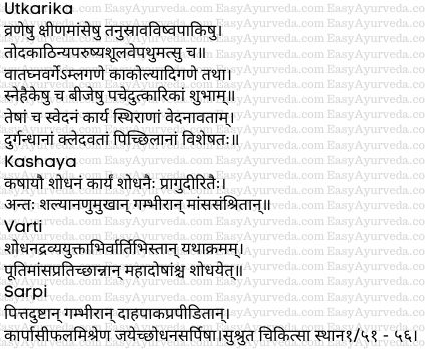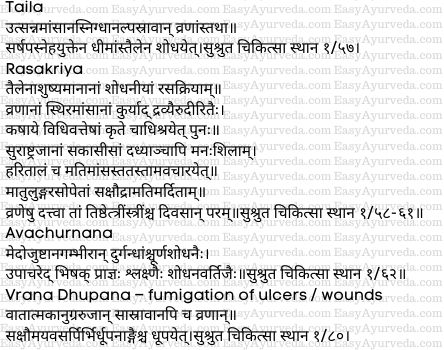Wound Cleansing, Healing by Sushruta (Shodhana And Ropana) Types, Details
By Dr Raghuram Y.S. MD (Ay) & Dr Manasa, B.A.M.S
Shodhana and Ropana are the fifth and sixth forms of treatment categories included in ‘Sapta Upakrama’ i.e. 7 types of treatments explained by Master Sushruta. They aim at healing and treating the ulcers, wounds and swelling related to these conditions and also to prevent the complications of the same.
Read – Sushruta’s 7 Types of Treatments Sapta Upakrama
Shodhana and Ropana
“Fifth of all shodhna should be done and the sixth measure would be ropana”
Shodhana means cleansing. Ropana means Healing. Both these groups of treatments are discussed together.
Thirteen treatment methods from amongst the list of 60 treatments mentioned under shashti upakrama are included under shodhana and ropana measures. They should be selectively used by the surgeon in treating the ulcers and wounds as per their condition, manifestation and presentation.
Anyhow shodhana and ropana, though explained together, they are mentioned as separate treatments amongst the sapta upakrama. Shodhana and Ropana serve similar purpose. In fact ropana happens after shodhana. Even after cleansing the ulcers and wounds with shodhana if they do not heal properly, the next measure i.e. ropana should be resorted to. Ropana will be separately considered in another article.
Read – Charaka Vrana Chikitsa – 25th Chapter – Wounds, Ulcers

Table of Contents
Sanskrit Verses



Types
Mainly 13 treatments are included under shodhana and ropana from amongst the 60 treatments mentioned in Shashti Upakrama.
| Sl No | Name of the Upakrama (treatment) | Meaning |
| 1 | Sandhana | union of fractures |
| 2 | Peedana | compression |
| 3 | Shonita sthapana | stopping the bleeding, enabling proper circulation |
| 4 | Nirvapana | application and showering of cold potency medicines |
| 5 | Utkarika | application of warm, semi-solid vata alleviating medicinal pastes to treat wound inflammation and necrosis of wounds |
| 6 | Kashaya | use of herbal decoctions |
| 7 | Varti | use of suppositories |
| 8 | Kalka | application of herbal pastes |
| 9 | Sarpi | use of medicated ghee |
| 10 | Taila | use of medicated oils |
| 11 | Rasakriya | administration of semi-solid medicinal extracts |
| 12 | Avachurnana | sprinkling of herbal powders |
| 13 | Vrana Dhupana | fumigation of wounds |
Read – Shashti Upakrama Meaning, Classification, Clinical Significance
1. Sandhana – union of fractures
Conditions in which union needs to be done – The same conditions explained in the context of seevana included in Patana group of treatments are applicable for union of fractures also. They are –
- Apaka upadruta – ulcers not associated with complications of suppuration
- Mamsa sthita – ulcers localized in the muscles
- Vivrta – open ulcers
2. Peedana – compression
Conditions in which compression needs to be done –
- Puya Garbha – having pus pockets (ulcers filled and surrounded by pus)
- Anu dwaran – ulcers / wounds having small openings
- Marma gatan vranan – ulcers located on vital organs, tissues)
How to compress the ulcers and wounds?
When these conditions persist, paste of herbs used for compression is applied over and around the ulcer so that it is compressed.
The herbal paste applied over the ulcer / wound is allowed to dry in place. When the opening of the ulcer / swelling are minute, the paste of herbs should not be applied over the orifice. When the opening of the wound / ulcer / swelling is not covered the doshas (pus etc) accumulated in them keep draining due to the compression imparted on them by the medicinal paste.
Read – Injury, Wound care Ayurvedic Remedies, Medicines
3. Shonita Sthapana – stopping the bleeding
When severe and uncontrolled bleeding occurs due to procedures like bloodletting or otherwise, the bleeding should be immediately checked by administering the shonita sthapana vidhi i.e. measures for controlling the bleeding as explained in the previous contexts (Su.Su.Ch14).
Four effective methods of checking excessive bleeding from ulcers / wounds are –
- Sandhana – unification
- Skandhana – coagulation
- Pachana – digestion
- Dahana – cauterization
Read – Bleeding Disorders: Ayurveda Treatment, Diet, Home Remedies
4. Nirvapana – application and showering of cold potency medicines
Conditions in which cold potency medicines should be showered on the ulcers – Due to the severe aggravation of pitta when the ulcer / wound gets associated and afflicted with burning sensation, suppuration and fever and vitiation of blood, the ulcers should be washed / showered / applied with medicines having cold potency.
‘The medicines used to pacify the pain and other symptoms associated with the ulcers caused by vitiated pitta and blood, which is in the process of getting suppurated, and associated with fever are called as nirvapana’.
Types of Nirvapana – Nirvapana is of two types. They are
- Seka – showering the ulcers and wounds with medicinal liquids
- Lepa – anointment of the ulcers and wounds with medicinal paste
How to do?
The herbs of cold potency should be ground in milk, mixed with ghee and applied on the ulcer in the form of thin paste. The same medicine is used for showering the ulcer.
5. Utkarika – application of warm, semi-solid, vata alleviating medicinal pastes to treat wound inflammation and necrosis of wounds
Conditions in which warm pastes is applied on the ulcers / wounds –
- Kshina Mamsa – depleted and thinned out muscles in the vicinity of ulcers
- Tanu srava – ulcers with thin exudates
- Apaka vrana – ulcers which are not suppurating
- Toda – ulcers associated with pricking pain
- Kathinya – hardness around the ulcers
- Parushya – roughness around the ulcers
- Shula – ulcers associated with pain
- Vepathu – ulcers associated with tremors
How to do?
Bhadradarvadi group of herbs (herbs which cure vitiated vata), Amla gana (sour group of things), Kakolyadi Gana group of herbs and oily seeds is processed to prepare warm paste which is semisolid and applied on the afflicted site so as to provide sudation. Sudation should be done over the immobile, painful, foul smelling, decaying and slimy ulcers.
Read – 4 Types Of Swedana As Per Sushruta And Vagbhata
6. Kashaya – use of herbal decoctions
Shodhana Kashaya – Herbal decoctions having ‘cleansing action’ only shall be used for this purpose. The purpose is to bring about cleansing the wounds and ulcers.
The below mentioned herbs may be considered for preparing the cleansing decoctions –
- Shankini – Euphorbia dracanculoides
- Ankotha – Alangium salviifolium
- Malati – Aganosma heynei
- Karavira – Nerium indicum
- Suvarchala (suryamukhi) – Helianthus annus
- Aragvadhadi Gana – Aragvadhadi group of herbs
Conditions in which cleansing herbal decoctions should be administered in treating the ulcers and wounds –
- Antah shalyan, anu mukhan – ulcers having foreign object inside them and also have minute opening
- Gambhiran – deep seated ulcers
- Mamsa samshritan – ulcers located in the muscles
7, 8 Varti – suppositories and Kalka – herbal pastes
Conditions in which suppositories and herbal pastes are administered for cleansing the wounds – The suppositories (wicks) and herbal pastes are used in the same conditions and are prepared with the same herbs. Below mentioned are the conditions for their usage –
- Puti mamsa pratichchannan – ulcers covered with decayed muscles
- Mahadosha – in severe aggravation of doshas
Herbs which are used for cleansing purposes are used in both these treatments.
Kalka – The herbal pastes should also be prepared using the same herbs with which the suppositories are prepared. As many herbs available shall be used. When using the suppositories the thin, thick, thicker and thickest types of wicks shall be used in that order according to the ulcer being treated. The physician / surgeon shall judge so as to in which condition the suppositories / wicks should be used and in which conditions the pastes need to be applied.
Read – Pakwashaya Shodhana Basti: Medicated Enemas For Colon Cleanse
9. Sarpi – use of medicated ghee
Conditions in which medicated ghee should be used –
- Pitta pradushtan – ulcers contaminated by vitiated pitta
- Gambhiran – ulcers which are deep seated
- Daha paka prapiditan – ulcers troubled by (association of) burning sensation and suppuration
When the above mentioned conditions prevail in the ulcers / wounds, cleansing ghee prepared with cotton seeds (Gossypium herbaceum Linn) should be used.
10. Taila – use of medicated oil
Conditions in which medicated oil need to be used –
- Utsanna mamsan – elevated muscles around the wounds and ulcers
- Asnigdhan – dried out ulcers / wounds
- Alpa sravan – ulcers / wounds having less (scanty) discharges
Ulcers associated with the above mentioned conditions shall be cleansed using sesame / mustard oil prepared with herbs having cleansing property.
11. Rasakriya – semi-solid medicinal extracts
Conditions in which semi solid herbal extracts need to be used –
- Tailena ashuddhyamananam – those ulcers / wounds which cannot be cleansed by administering cleansing oils
- Sthira mamsanam – stiff / unmovable muscles around the ulcers
In the above conditions of ulcers cleansing rasakriya (rasakriya prepared with cleaning herbs).
How to prepare Rasakriya?
The herbs having cleaning properties are taken and their decoction is prepared. This decoction is once again processed and added with alum, green vitriol, realgar and orpiment. Later this should be thoroughly mixed with juice of Citrus medica and honey. The resultant semi-solid preparation is called rasakriya. This should be administered / applied for cleansing the wounds associated with above mentioned conditions. This shall be used once in three days.
Read – Rasanjan Uses, Remedies, Dose, Side Effects, Research
12. Avachurnana – sprinkling / dusting of herbal powders
Conditions in which dusting of herbal powders need to be done –
- Medo jushtan – ulcers caused by vitiated fat (ulcers having fat)
- Agambhiran – ulcers which are not deep (superficial ulcers and wounds)
- Durgandhan – ulcers having foul smell
How to do?
The fine powder prepared from herbs having cleansing property (same as those used to prepare varti – suppositories) is sprinkled / dusted on the ulcers and wounds with above mentioned conditions.
13. Vrana Dhupana – fumigation of ulcers
Conditions in which fumigation of ulcers need to be done
- Vatatmakan – ulcers afflicted by vitiated vata
- Ugra rujan – ulcers associated with severe pain
- Saasravan – ulcers associated with discharges
For fumigation linen, barley, ghee and fumigation herbs Pinus roxburghii, Vateria indica etc are used.
Summary
The above mentioned measures of shodhana and ropana are useful in cleansing and healing the wounds and ulcers. Shodhana should be done first and after the wounds have been cleansed properly ropana should be resorted to for extensive and comprehensive healing of ulcers and wounds.
Shodhana, following the chronology should be done after patana (excision and other set of surgical methods). Following Ropana we have Vaikrutapaha – the seventh amongst the Sapta Upakrama which comprises of 26 treatments aimed at removing the deformities, complications and sequels of ulcers and wounds, a form of cosmetic rebuilding.
Ropana, as already mentioned are explained in the flow by Master Sushruta immediately after having explained the measures of shodhana. He has not included it amongst the 60 treatments and hence doesn’t get a number from amidst 1 to 60.
Shodhana measures explained above too are healing in nature but since ropana measures have separately been highlighted by master Sushruta without numbering it, we need to consider it as a separate treatment procedure. Anyhow it gets a number amongst the shad upakramas i.e. 6th among the seven treatments which the same author has explained in sutra sthana chapter 17.
Click to Consult Dr Raghuram Y.S. MD (Ayu)









